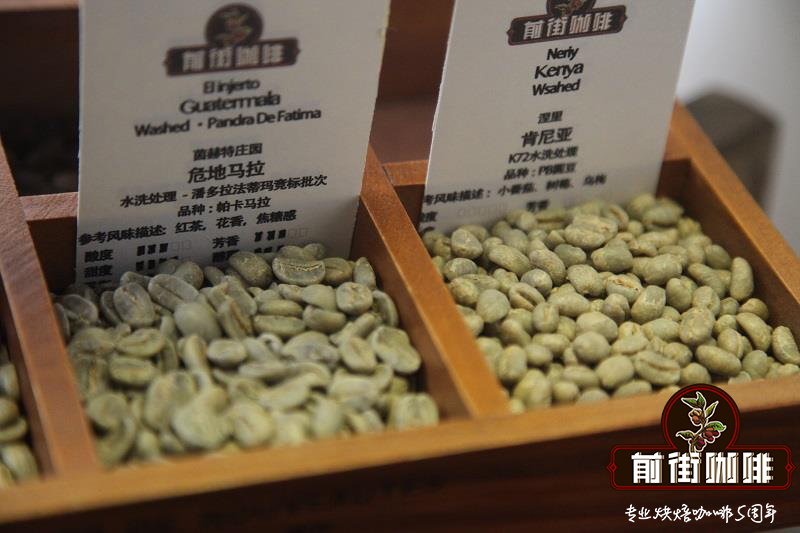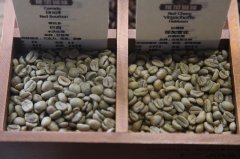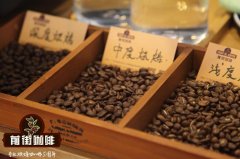Grade and Specification of Coffee beans Coffee Grade Classification and Coffee Grade Pyramid

Professional coffee knowledge exchange more coffee bean information please follow the coffee workshop (Wechat official account cafe_style)
The latest knowledge arrangement of raw coffee beans: the classification and naming rules of coffee beans
Grades and specifications of coffee beans
At present, each producing country has its own independent standards. The most commonly adopted criteria are as follows:
A: washing / non-washing
B: flat beans / round beans
C: filter screen (size of coffee beans)
D: classify by elevation
According to the elevation of the cultivated land, it can be divided into three, four, seven and other grades (different national standards). For example, Mexico and Honduras adopt three grades, while Guatemala adopts seven grades. Generally speaking, the quality of highland beans is better than that of lowland beans, and the price is higher because of the increase in freight.
E: quality Typ
The type and quantity of blends (defective beans) contained in a certain amount of samples are converted into "defective number", and a certain sum is taken as the basis for determining the type of quality. Brazil, Ethiopia, Cuba, Peru and other countries all have benchmarks for the number of defects, and the smaller the value, the better.
F: set specifications according to taste
Brazil, Haiti, Kenya, Zaire and other countries all have their own taste testing methods, which can be exported only after taste testing.
Sumatra Mandheling Manning Coffee
Made in Sumatra, Indonesia, it has a strong aroma, bitterness and charcoal burning taste.
Ethiopia Sidamo Ethiopian (mocha) coffee
The beans are small and fragrant, with a unique sour taste and citrus aroma, with a rich finish, usually known as mocha.
Panama Extra Fancy Panamanian Coffee
Coffee bred in good natural conditions and environment tastes sweet and soft.
Brazil Santos Brazilian Coffee
The concentration is sour, the taste is very smooth, moderate acidity and sweet and bitter taste with grass aroma, it is the best of Brazilian coffee beans.
Colombia Supremo Colombian Coffee
Well-known in the world, mellow flavor, and has a special soft sour taste, deeply loved by people.
Blue Mountain Blend Comprehensive Blue Mountain Coffee
The taste is sweet, smooth and slightly sour, making it the best coffee.
According to the statistical method, the type and quantity of dopants contained in a certain amount of samples are converted into percentage "defect number", and the basis for determining the quality class is that the smaller the defect number is, the higher the quality is.
According to the elevation of the cultivated land, it can be divided into three, four, seven and other grades. Generally speaking, the quality of highland beans is better than that of lowland beans, and the price is higher because of the increase in freight.
Grade name elevation (m)
1 first-class beans 1.500 cents-
2 first-class beans 1.200 color 1.500 color-
3 medium beans 1.000LMUR 1.200
4 special water washing beans 900murmur1.000
5 first-class water washed beans 760 murmur900
6 special water washed beans 610 murmur760
7 excellent water washed beans-610
Small and round dark brown coffee beans, quietly emitting a fragrant fragrance in the grinder, injected into the cup showing the beautiful color of amber, these are the three very deep impressions of coffee. As you explore the history and beauty of coffee, you can also see the coffee trees that are caressed by the tropical sun and whose leaves twinkle. It has small white flowers similar to jasmine, and its fruit changes from green to yellow-green, and finally to red. Coffee beans are the seeds in its fruit. Moreover, if you go to the coffee bean refinery, you will surely see the red pulp called coffee cherry and the fresh and green coffee raw beans with the endocarp and silver skin removed. These are the coffee beans for export. At present, there are about 60 coffee-producing countries, most of which are located in areas with an elevation of 300,000m and 400m, and sometimes coffee trees are cultivated on highlands with an elevation of 2000,000m, but those planted on slopes above 1500 meters above sea level are said to be of better quality. The most suitable condition for the cultivation of coffee trees is an area with an average annual rainfall of 1500murmur2000 mm and an average temperature of about 20 degrees, which will not defrost.
Coffee belongs to the evergreen plant of Akanaceae. If it is wild, it can grow to more than eight meters. But in the garden, the height will be cut to about two meters, in order to ensure the quality of coffee beans, and easy to manage. At present, the main tree species planted are Arabica species, Robusta species (Carneva species) and Liberika species. It can be subdivided into dozens of varieties, which will be distinguished in production, circulation and trading. Even in the same producing country, it will have a subtle influence on the flavor and quality of coffee beans and produce their own characteristics because of the differences in climate, altitude and soil quality in different regions. Therefore, according to the variety, origin, brand, there will be different attributes; therefore, it is impossible to describe the characteristics of a country's coffee beans in one sentence!
Specifications and grades of ◎ coffee beans
a. Washing / non-washing
Washing type: in the sink, after rubbing with water and utensils, the pulp and colloid are removed and dried, which is called washing coffee bean with uniform quality.
Non-washing type: after the sun is naturally dried, the pulp and peel is removed by a sheller, and its quality is unstable.
b. Flat beans / round beans
The fruit of coffee consists of two oval seeds opposite each other. The connecting side of each other is a flat joint, which is called flat bean. But there is also a round seed called a round bean, which tastes no different. Ripe and red coffee cherries have multiple structures. In the middle is the predecessor of the coffee bean, the light green seed.
Generally speaking, the fruit of coffee is made up of two oval seeds opposite each other. The side that connects with each other is a flat joint, so it is called flat bean. But some are made up of a round seed, and its taste is no different.
c. The size of coffee beans
Filter number (mesh no.) Coffee bean size
Pingdou 20murmur19 is very big.
18 big
17 quasi-big
16 ordinary
15
14 small
13Murray 12 extra-small
Green beans 13 murmur12 big
11 quasi-big
10 ordinary
9
8 small
d. Altitude
According to the elevation of the cultivated land, it can be divided into three, four, seven and other grades. Generally speaking, the quality of highland beans is better than that of lowland beans, and the price is higher because of the increase in freight.
Grade name elevation (m)
1 first-class beans 1.500 cents-
2 first-class beans 1.200 color 1.500 color-
3 medium beans 1.000LMUR 1.200
4 special water washing beans 900murmur1.000
5 first-class water washed beans 760 murmur900
6 special water washed beans 610 murmur760
7 excellent water washed beans-610
e. Quality
According to the statistical method, the type and quantity of dopants contained in a certain amount of samples are converted into percentage "defect number", and the basis for determining the quality class is that the smaller the defect number is, the higher the quality is.
f. Taste
Brazil, Haiti, Kenya, say and other countries all have their own taste testing methods, which can be exported only after taste testing.
Arabica species and Robusta species
Arabica and Robbita species account for about 2/3 of the world's coffee production. It is not suitable to grow in areas with high temperature, low temperature, more rain and less rain. The bean is oval shoulder flat, which is characterized by strong fragrance and good quality.
Robusta is bitter but not sour, and the flavor is not very good, so it is suitable for making mixed coffee. Mixed with the right amount of robusta in Arabica, it is usually used to make iced coffee, instant coffee and canned coffee. It is characterized by growing in lowlands. Strong disease resistance.
The quality and output of Liberika are not good. Most of them are exported to Europe, but not imported to Japan.
From harvest to shipment
After the fruit is harvested, the outer skin, pulp, endocarp and silver skin should be removed before shipping. There are two kinds of methods: drying (also known as natural or non-washing) and washing. The drying method is relatively simple.
First of all, spread the freshly harvested fruit on the exposure field for a week or two until the fruit crackles and dries naturally.
After that, the dried pulp, endocarp and silver peel are removed by a sheller.
New crop (new bean) luster is light green, with a unique sour taste and coffee aroma, very distinctive. (right)
Past crop (annual bean) has a yellowish color with a light green color, which is sour and milder than the new bean. (middle)
Old crop (multi-year bean) is yellow due to water loss, slightly sour and ordinary in taste. Usually used as a blend and brewed into canned coffee. (left)
Transferred from Qimo intellectuals
World Top Coffee beans-Kenya aa Coffee beans Kenyan Coffee has 7 grades
Important Notice :
前街咖啡 FrontStreet Coffee has moved to new addredd:
FrontStreet Coffee Address: 315,Donghua East Road,GuangZhou
Tel:020 38364473
- Prev

What is the meaning of standard coffee bean grade G1 and coffee grade shb
Professional coffee knowledge exchange more coffee bean information please follow the coffee workshop (Wechat official account cafe_style) the latest coffee raw bean knowledge collation: coffee bean classification and naming rules common coffee bean grade classification: Grade1 (level 1): washed bean top Grade2 (level 2): washed bean standard grade Grade3 (
- Next

An introduction to the main coffee producing areas and the characteristics of coffee beans in the world
Professional coffee knowledge exchange more coffee bean information please follow the coffee workshop (Wechat official account cafe_style) the latest coffee raw bean knowledge collation: coffee bean classification and naming law coffee brand ● main producing area and high quality strict selection of beans at present, there are many kinds of imported coffee beans from all over the world, here will introduce the main producing areas and the characteristics of coffee beans
Related
- Beginners will see the "Coffee pull flower" guide!
- What is the difference between ice blog purified milk and ordinary milk coffee?
- Why is the Philippines the largest producer of crops in Liberia?
- For coffee extraction, should the fine powder be retained?
- How does extracted espresso fill pressed powder? How much strength does it take to press the powder?
- How to make jasmine cold extract coffee? Is the jasmine + latte good?
- Will this little toy really make the coffee taste better? How does Lily Drip affect coffee extraction?
- Will the action of slapping the filter cup also affect coffee extraction?
- What's the difference between powder-to-water ratio and powder-to-liquid ratio?
- What is the Ethiopian local species? What does it have to do with Heirloom native species?

